4 Proven Ways To Pitch Top-tier Media Outlets (Forbes and The Like)
Imagine receiving a query from a reporter who’s working on an article that has to do with your industry.
You send them a reply back with the relevant information, then go weeks without a reply until….
Boom. You get a Google Alert letting you know your name has been mentioned in an article in The New York Times.
And all of a sudden, you’re getting massive spikes in traffic.
As well as a few more placements from other news sites sharing that same article.
Business begins to pick up, and all you had to do was take a few minutes to respond to a query that was hand-delivered to your inbox.
All because you did something insanely simple – you let people know who you are.
Welcome to HARO.
What’s HARO? All You Need To Know
An acronym for Help A Reporter Out, HARO is a sourcing service that connects journalists and bloggers with experts and businesses relevant to articles they’re working on.

It originally started in 2008, when PR giant Peter Shankman (commonly referred to as “the rockstar of social media”) realized that the hundreds of requests he received from the press could be serviced in a better way.
So, he began to compile them into a list and send these queries to his list of fellow PR professionals and voila! More and more people began to sign up for his list and the most popular sourcing service in the English-speaking world was created.
The process is simple—reporters send their queries to HARO, which then distributes them to their email subscriber list, where users can then go through the queries and respond to the ones they want to earn a mention from.
HARO runs on a freemium model, which means that you can get general access to media queries for free. However, it also offers paid plans with additional features as you can see below.
In summary, you should use HARO if you want to get yourself or your business featured in publications all over the web.

Now, the name of the game when using HARO is speed. There are over 800,000 sources fighting to get mentions, so it’s often only the first few businesses that respond with relevant information that get an article placement.
This can make it tempting to opt for the paid plans HARO offers, since they help streamline the process and make it easier to find queries that are relevant to your industry.
However, you can also land a ton of placements using the free version of HARO by using our proven system.
The thing is that in order to get a link placement, you need three qualities:
- Quick response times
- The right responses to land you mentions
- And the ability to stay on top of things.
And while it may seem complicated, it’s actually ridiculously easy to tick all three of these boxes without paying a dime. Let’s take a look at how.
Step 1. How to respond quickly
1. Create a new inbox specifically for HARO

Then, make your way to “Inbox” and under “Inbox type” select “Multiple Inboxes”. A new section titled “Multiple Inbox Sections” will appear. Simply type in from:(email address you want to receive in this inbox) and click on the “Save changes” button at the bottom of the screen.

2. Set up an email filter to find relevant requests
Now, with so many queries coming in you’ll want to set up an email filter that will capture the specific queries that you want. You can do this by again navigating to the gear wheel at the top right corner of your inbox and clicking on “See all settings”.
Then, make your way to “Filters and Blocked Addresses”.

Now, scroll down and select “Create a new filter”.
A window will pop up like the one below. Fill out the “From” form with the HARO list email address and fill in any keywords that are relevant to your business in the “Doesn’t have” space.Then, hit “Create filter”.
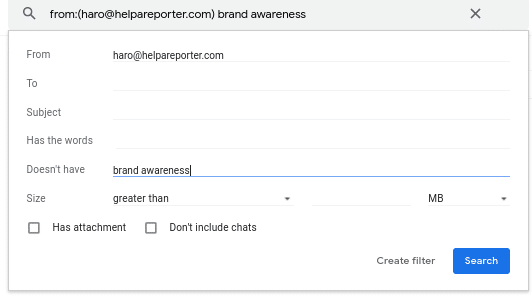
You can then finalize your filter using the options below. To make sure only relevant emails with your keywords show up in your inbox, simply click on the “Delete it” button.
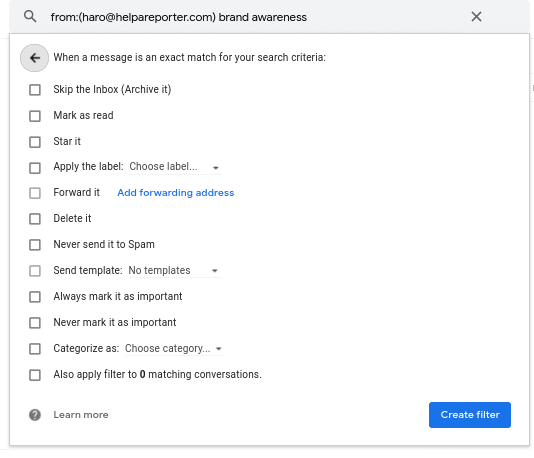
Congratulations! You now have an inbox that will only filter through emails that contain your keywords and filter out all the rest, saving you a ton of time when searching through potential queries.
Step 2. How To Respond To Queries The Right Way To Get Mentions
Now that you know how to filter through your HARO pitches, you need to learn how the reporters you respond to filter through theirs.
This is important, because just like your inbox is flooded with queries, reporter inboxes are flooded with businesses who also know that PR is 90% more effective than advertising.
That means responding to queries the right way comes down to two things:
1. Speed
Writers have deadlines and a ton of replies coming in, so you want to make sure that your response is one of the first ones they see. HARO sends out queries three times a day at 5:35am, 12:35pm, and 5:35pm ET, so you’ll want to make sure that you’re checking your inbox at those times.
Keep in mind as well that HARO has a massive email list, so their send times may be staggered to stay in compliance with their email provider. If you don’t receive queries at those times, chances are you’ll receive them within the hour, so keep a lookout. Once 12 hours have gone by, you’ve probably lost that opportunity.
2. Relevance
Being one of the first to land in their inbox won’t do you much good if your reply isn’t relevant to what the reporter is looking for. It’s important to make sure that your pitch is specific to the query you’re replying to.
Because reporters are on deadlines and swamped with requests, they’ll often send out queries designed to get them the information they want as quickly as possible. Take the time to read their queries and answer them as succinctly as possible.
Responding with a generalized “Would you like to schedule an interview?” or a lengthy bio about your business is a surefire way to get ignored. Check out the example below.

By sending a pitch like this, you’re making the reporter work harder and with so much already on their plate, they’re just not going to bite.
3. Perfect Examples of Successful HARO Pitches That Get A Reply
Now that you know what a pitch SHOULDN’T look like, let’s take a look at 3 pitches that will get you a reply.
Pitch 1. The story pitch

Why is this a good example?
A pitch like this will be successful because it effectively shares a story while focusing on how it can provide value to the writer’s audience. If you can show off your expertise while wrapping it within the context of a story, you’ll have a more engaging pitch than most of your competition.
How to use this example the right way?
- When the query is in need of source quotes
- When there’s a need for context surrounding your expertise
- When you need to send a unique pitch that will stand out
Pitch 2. The bullet pitch

Why is this a good example?
Because reporters have so many pitches they have to go through, presenting your pitch with bullet points is a great way to make sure reporters can skim through and find relevant information quickly. Otherwise, they might deem your pitch too much work to go through and not even look at it.
How to use this example the right way?
- When you want to summarize the key components of your pitch
- When you want to make a point quickly and clearly
- When the query is in need of statistical data or analysis
Pitch 3. The name-drop pitch

Why is this a good example?
The name-drop pitch can be extremely powerful, when done right.
You don’t want to just name drop a bunch of awards or publications if they aren’t relevant to the reporter you’re pitching to. However, if you’ve worked with someone that they know or have credentials related to the piece they’re writing about, a name-drop pitch can give you a leg up on the competition.
How to use this example the right way?
- When you know there will be a lot of competition for a query
- When you have a relevant connection to the reporter or piece they’re working on
- When you want to place an emphasis on your expertise/reputation
Remember, you want to make the writer’s life easier by working with you. Here’s a quick checklist to run through to make sure you’re maximizing your chances at getting a mention:
- Is your subject line interesting and relevant to their query?
- Did you address which query you were responding to? This is important because writers will often put out multiple queries at a time.
- Did you answer the questions asked in the query?
- Did you follow all of the reporter’s instructions?
- Do your credentials match what the reporter is looking for?
- If sourcing a quote, did you include all relevant information? This can include the source’s name, position, company, and headshot.
- Did you include multiple ways for the reporter to get in touch with you? It’s usually a good idea to include your email, phone number, Skype, or Twitter so that they can reach out quickly if they need to.
Why is this a good example?
Step 3. Automate Your HARO PR Outreach Using These 3 Free Tools
The thing about HARO is that it’s an ongoing process and if you’re not careful, it can quickly suck up all of your time. That’s why we’ve handpicked 3 free tools you can easily implement into your HARO system to automate the process.
1. Create Outreach Templates
Creating an outreach template can significantly reduce time spent on HARO outreach since it allows you to quickly plug in information instead of creating a new pitch from scratch every time.
All you have to do is create your message in Gmail, navigate to the three vertical dots in the bottom right hand corner, click on “Templates”, and then hit “Save draft as template”.
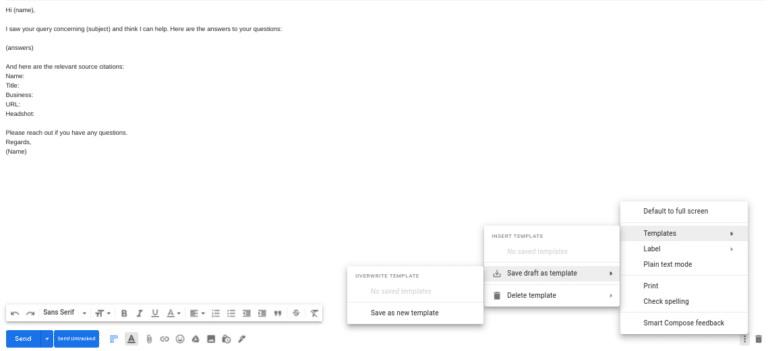
Now, you have a framework you can use to create your pitches. All you have to do is switch out the relevant information and paste it into the
2. Set up Google Alerts
A lot of the time reporters are so busy that it can take weeks for them to let you know that your placement is live, making it hard to keep track of and leverage your placements.
You can avoid this simply by setting up Google Alerts for yourself and your business and keeping a record of your mentions using a spreadsheet. This way, you’ll be able to track and take advantage of your mentions.

3. Use Google Calendar Alerts to keep in contact with reporters
One of the best ways to land juicy placements before they even hit HARO is by building relationships with reporters. If you’ve successfully gotten a mention with a writer in your industry, use Google’s Calendar Alert feature to schedule a reminder to reach out and let them know where you’ve shared their piece or even forward any relevant pieces in return.
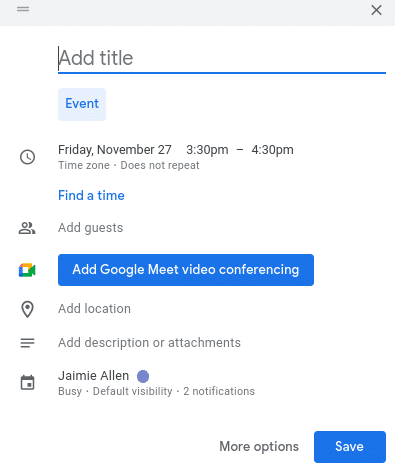
Step 4: What to do with All of Your New Mentions?
Take them. Bask in them. Pop some champagne.
Call your mom and proudly tell her that you’ve been featured in a magazine that gets thousands of readers a month while drinking said champagne.
Then buckle up your seatbelt and get ready because this is just the beginning.
Because while you can get dozens or even hundreds of features through HARO….
The real PR opportunities are when you begin to really see the needle move.
I’m talking about the kind that gets you featured alongside experts like Grant Cardone…
That takes you from an expert nobody knows about…
To an expert everybody knows about.
These kinds of placements are insanely difficult to get on your own for one simple reason.
And that reason is they make you a ton of money…
So everybody wants them.
Because when you’re featured in exclusive pieces alongside experts like Gary Vaynerchuck, people treat you differently…
Instead of offering discounts to get clients through the door, you need to hire a doorman to keep them from flooding your store.
Instead of being ignored on social media, people hang onto your every word.
Instead of scrimping and saving every month, you spend money easily because you know more cash flow is going to come walking through that door.
Just ask Hanalei Swan, who became the youngest fashion designer to ever be showcased at Pure London Fashion Week at the age of (insert age) after working with us.
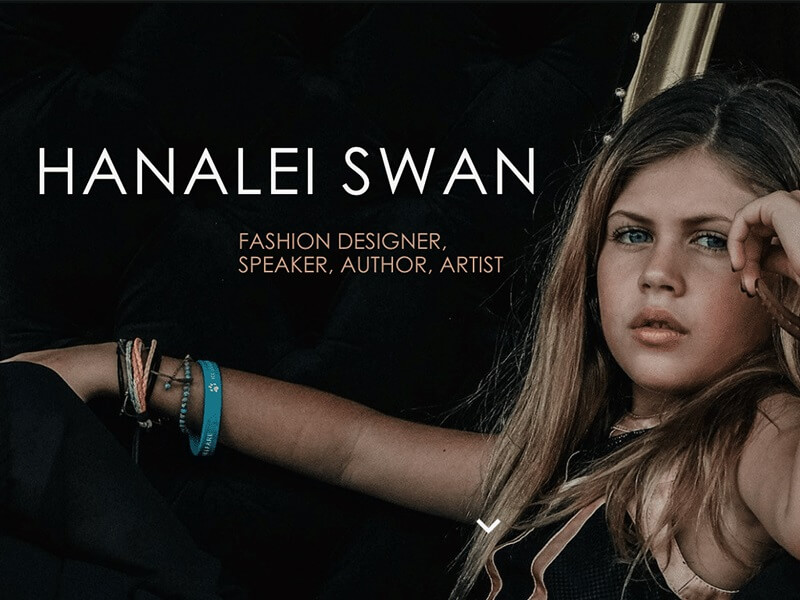
With our help, Hanalei was able to take her business from $20 (yep, you read that right) to 6 figures in a matter of months. And the perks that came with that, including…
- All expenses paid travel to speak at various marketing, personal development, and fashion events in Paris, Las Vegas, Orlando, and The Maldives through the use of strategic partnerships…
- Skyrocketed Instagram growth, taking her from 0 to 50,000+ raving followers…
- A feature on the #1 ranked podcast for entrepreneurs, Unconventional Life, hosted by Inc Magazine’s #1 of the “Top 27 Female Entrepreneurs Changing the World”, Jules Schroeder.
And the best thing is that this is a replicable system we’ve used for countless other entrepreneurs…
Like Suzi McAlpine, who teamed with us for an upcoming product launch and made $22,931 in a single day…
Or
Or maybe even you.
If you’re tired of being an overworked entrepreneur…
And ready to become a well-paid expert….
Just fill out the application here and we’ll be in touch…
And we’ll see what kind of magic we can make happen for you.
Rhonda Swan
Rhonda Swan is an International Speaker, Best Selling Author, Personal Branding and Business Strategist. Rhonda is the CEO and Founder of the Unstoppable Branding Agency where she works alongside visionaries, experts, entrepreneurs, and businesses that go from being the world’s best known secret, to the world’s best-known expert with PR, Media and Expert Branding.
